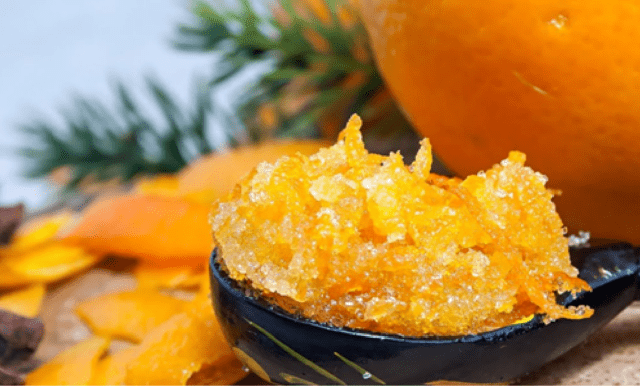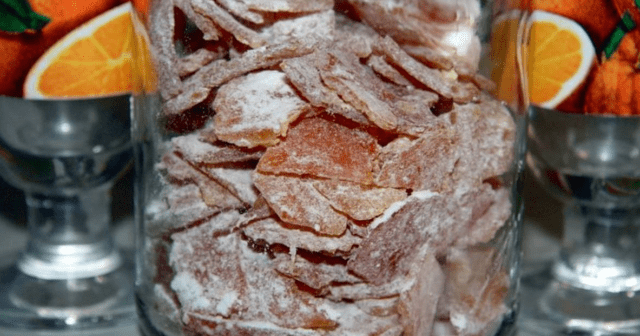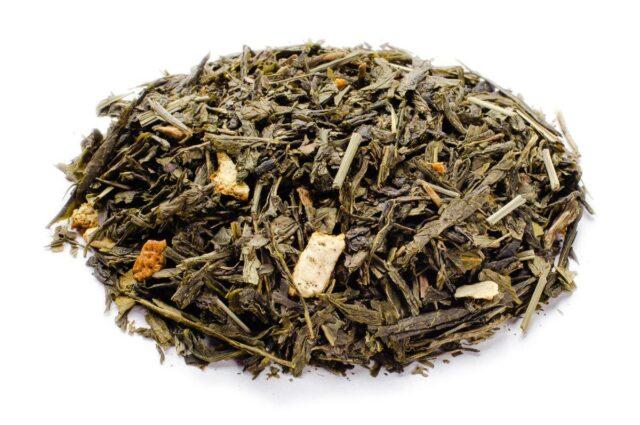Content
Tangerine peels can be eaten, as well as a medicine (for insomnia, dysbiosis, nail fungus and other pathologies). Zest is used as a cosmetic for whitening nails and skin rejuvenation. It can also be used in decor, as a freshener and natural insecticide.
Mandarin peel composition
The zest is the top layer of the tangerine rind (no white layer). It is she who has an attractive color and strong aroma. The smell is given by essential tangerine oil (1-2% mass fraction), the composition includes:
- simple carbohydrates (sucrose, fructose);
- citral;
- aldehydes (including caprylic);
- anthranilic acid ester (gives a citrus aroma);
- limonene;
- antioxidants;
- lower alcohols.
Along with essential oil, mandarin peel contains organic orange and yellow pigments (including carotene). It is found in other orange-colored foods such as carrots, pumpkins, and melons.
How many calories are in a tangerine peel
The benefits and harms of mandarin zest are determined not only by the composition, but also by the nutritional value.

Mandarin peel is no less useful than the fruit itself
This is a fairly high-calorie product - 97 kcal per 100 g (fresh). This is 2 times more than that of the fruit itself (42 kcal per 100 g). Nutritional value for the same weight:
- proteins - 1.5 g;
- fats - 0.2 g;
- carbohydrates - 14.5 g.
The calorie content of mandarin peel is explained by the high carbohydrate content. However, the zest is consumed in small quantities, so it will not affect excess weight in any way. For example, if you put 30 g in tea, the calorie content will be less than 30 kcal (with a total daily rate of 1600-2000 kcal).
Is it possible to eat mandarin peel
Mandarin peel can be eaten, but only from healthy, thoroughly washed fruits. To get a clean zest, you must:
- Wash the tangerine.
- Pour boiling water over (optional).
- Peel off the top layer (no white film) with a sharp knife with a thin blade.
- Chop finely into pieces.
You can also work with a fine grater. Then it is enough to rub only the top layer and put the zest to dry or immediately use it in tea or other drinks.
What are the benefits of tangerine peels
The benefits of tangerine peel for the body are the beneficial effects on various organ systems. Zest:
- lowers blood pressure;
- reduces blood glucose levels;
- lowers the temperature;
- helps to cure bronchitis;
- stimulates the synthesis of gastric juice, which facilitates digestion;
- helps to cope with insomnia and nervous tension;
- helps to relieve puffiness;
- improves blood flow;
- increases the effect of painkillers;
- participates in cancer prevention;
- clears blood vessels from cholesterol accumulations;
- stimulates fat burning, which is important when losing weight;
- has an immunostimulating, anti-inflammatory, antiseptic effect.
Its use leads to the awakening of sexual feelings, and also tones the body.
Using tangerine peels
Mandarin zest is quite useful, therefore it is used for both medicinal and culinary purposes.Also, the peel is used in cosmetology, gardening and even in decor.
In cooking
Mandarin peel has not only an interesting aroma, but also a piquant taste. It has sweet and sour tones and a slightly bitter aftertaste. The smell and taste are well expressed, so the peel is used in small quantities.

Zest is added to baked goods, used for making tea and other drinks
Main directions of use:
- As a fragrant addition to the dough, in the form of decoration.
- For non-alcoholic and alcoholic drinks, including tea or coffee.
- For jam or preserves.
Therefore, you need to remove the zest very carefully.
You can make candied fruits from the peel. This will require the following ingredients:
- peeling tangerines - 300 g;
- sugar - 300 g;
- water for syrup - 150 ml.
Recipe:
- Wash the fruits.
- To peel.
- Soak it in salted water for 8-10 hours.
- Throw in a colander, let the liquid drain.
- Pour water into a saucepan and add tangerine peel. The liquid should cover the product.
- Cook for 5-7 minutes over low heat.
- Throw in a colander, let cool.
- Cut into strips 6–8 mm wide.
- Make a syrup with sugar and water.
- Throw the peel into a sweet composition and cook for about one hour. During this time, the liquid should boil away.
- Pour candied fruits onto paper and let dry.

Store citrus peel sweets in a glass container
In medicinal whole
The beneficial properties of the tangerine peel have found their application in folk medicine:
- To eliminate insomnia and relieve nervous tension: 100 g of mandarin peel is placed in 2 liters of boiling water, infused for 1 hour, filtered. Poured into a warm bath before bed.
- For the prevention of dysbiosis: tangerine peel powder is added a teaspoon to any dish, for example, to porridge, yogurt or an omelet.
- To treat nail fungus: Rub the plates with fresh mandarin peel several times a day.
In cosmetology
Essential oil and other useful components have a beneficial effect on the skin, as well as on the nail plates. They are used in phytocosmetics and homemade recipes, for example:
- Face mask: the resulting zest is ground in a blender to obtain a powder. You need to take it in the amount of 1 tsp, add 1 chicken egg yolk and 1 hour. l. sour cream 15–20%. Mix everything well and apply on face for 20 minutes.
- To whiten the nail plates, you can rub them with zest every day, and it is better to do this 2-3 times.
- The tangerine peel is crushed to a powder, a little warm water is added and a ready-made scrub is obtained. It is rubbed into the body after a shower. Thanks to this procedure, the skin will become softer and more attractive.
In decor
Dried zest is also used for decoration, for example, you can make from it:
- roses;
- garland;
- Christmas wreath;
- candlestick.
For these purposes, it is better to take the peel of large tangerines or oranges.

An interesting Christmas garland can be made from citrus peels and other decorative elements.
At home
Mandarin peels are also used at home, for example:
- Air freshener (zest of four fruits, 2 tablespoons of vinegar 9%, 1 teaspoon of cloves and 4-5 g of cinnamon and vanillin). Grind, mix the ingredients and bring to a boil in 1–2 liters of water. Cool and pour into plates, place on the windowsill, on the table.
- Cut the zest into molds, dry it, make holes on top and thread in a thread or ribbon - you get original Christmas tree decorations.
- The zest can be thoroughly rubbed on a cutting board (preferably with tangerine pulp). Thanks to this, all unpleasant odors will disappear immediately.
Application in the garden
The peel of tangerine, orange and other citrus fruits is used as an organic fertilizer. Moreover, it is not necessary to obtain a zest for this - you can take peelings, cut them and bury them in the soil at a shallow depth (5–7 cm).They can also be thrown into the compost pit along with leaves, shoots and other organic materials. Gradually decomposing, the peel gives off nitrogen substances that stimulate the growth of other plants.
Another option is to use an infusion on the tangerine peel to combat aphids, thrips and other pests:
- Take peel of six fruits.
- Pour in warm, but not hot water (1 l).
- Insist in a dark place for 6-7 days.
- Strain, add 2 liters of water and a large spoonful of liquid soap.
- Spray foliage and shoots.
Mandarin Peel Drinks
Tangerine peels can be used to make interesting drinks. For example, it is added to tea and even coffee to enrich the taste. Also, on the basis of the zest, decoctions and infusions are prepared, from which any festive drinks can be made.
Tea
To prepare one glass of tea, take a pinch of chopped mandarin peel. The recipe is standard:
- Mix the ingredients in a glass or teapot.
- Pour boiling water over.
- Close with a ceramic lid and let it brew for 15–20 minutes.

Regular consumption of tea with zest boosts immunity
Decoction
To prepare the broth, take 10 parts of water per 1 part of the zest, for example, 100 g of chopped mandarin peel per 1 liter of water. The instruction is simple:
- Put water on fire.
- After boiling, put the pre-chopped tangerine peel.
- Simmer over medium heat for about 30 minutes. The lid must be closed.
- Let it brew. After that, the drink must be cooled to room temperature.
Sugar (or honey) is added to the resulting broth, as well as citric acid to taste. The chilled drink can be used as an original kind of lemonade.
Infusion
On the basis of chopped mandarin peel, you can also prepare an alcoholic infusion. You will need the following ingredients:
- zest - 25 g;
- vodka - 0.5 l;
- sugar 120-150 g;
- water - 350 ml.
Instructions for preparing the tincture:
- Chop the tangerine peel in any convenient way.
- Pour 350 ml of water into a saucepan, bring to a boil.
- Dissolve sugar, stir.
- Combine with vodka.
- Cover with chopped mandarin peel.
- Close the container and put it in a dark place for a week, shake it periodically.
- Strain.
Harm of tangerine peels and contraindications
The main harm of the tangerine peel is due to the fact that it is on it that pesticides and other harmful substances get. If the fruit has an unnatural shine, green spots, cracks or other damage, it is not worth buying.
Moreover, even environmentally friendly zest is contraindicated for use:
- allergy sufferers;
- patients with gastritis, ulcers, colitis and other pathologies of the digestive system;
- people with kidney disease.
For pregnant and lactating women, doctors recommend using the peel with caution.
Conclusion
Tangerine peels are a valuable source of essential oil and antioxidants. Therefore, they can be used not only for food, but also as a medicine. On the basis of the zest, baked goods and drinks are prepared. Also, the peel is used in home life and in gardening.








